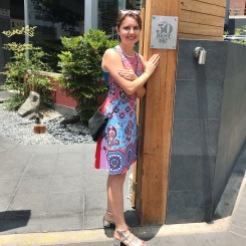
I just came back from a 3-week trip in Peru – partly as a study trip with my university, partly on my own. Peru is an amazing country, one of the top biodiversity countries in the world. It has 70 % of the planet’s microclimates, meaning that there are tons of different ecosystems (11 to be precise) creating different environments. In other words, this means there are lots and lots of varieties of species in the food kingdom.
Peru can be divided into three parts: the coast, the mountains (Andes) and the Amazonia; I was lucky to visit all three of these week by week. Lima is the capital and it is huge! It reminded me of southern California in a way, because it is overlooking the ocean, there are tons of surfers, tons of hipster, healthy organic cafes. Just the vibe there made me nostalgic of “home”.

The first week I was in Tarapoto, a small-ish town in the north-east part of Peru, right on the border with the Amazonian forest that continues till Bolivia. I was there with 4 other friends and we did lots of outdoor activities. We went trekking through rivers, saw
waterfalls, visited cacao and chocolate producers, explored lagoons, ate tons of plantains and much more. The weather was very hot and humid (30-35 celsius), so lots of mosquito spray is required there. We noticed a lot of natural medicine centers and retreats and we visited an Ayahuaska one as well (very common there, people hallucinate on this drink made out of the plant and is considered a natural remedy for many mental and physical issues. It has been used forever, but in the past years has become “trendy” for westerners too that will travel to these countries to use it).
After spending a week in the hot Amazonia we traveled to Lima and met up with the rest of the group (we were 15 in total, students plus our tutor). Lima has become a big Foodie city and high-cuisine gastronomy has become popular in the last 25 years. Today many of the top 50 best world restaurants are in Lima. Probably the most famous one is Central by chef is Virgilio Martinez, but there are so many more. There has been a big Japanese immigration in the last century so there are tons of fusions between the two cuisines. Lots of ceviche places to eat also.
Below are some of the places we visited in Lima:
–MAIDO: we had the tatsing menu; it’s a fusion between Japanese and Peruvian cuisine. It’s in the top 50 best world restaurants.
–AMAZ : by chef Pedro Schiaffino. He made a huge research on indigenous Amazonian communities; he uses these ingredients, buying them directly from these people. He met with us and we did a workshop and tasting of different products (it was amazing), and later had dinner.
–PAN DE LA CHOLA: it’s a bakery with incredible sourdough products and other.

-Markets: SURRILLO, MIRAFLORES, BIOFERAS (organic)
–LA MAR : we were doing a ceviche tour that day and this was one of the stops, it is owned by famous chef Gaston Acurio. Another stop was at “Al Toke Pez“, a much more casual place but the food was incredible and the chef serves more sustainable fish.
The last week we traveled to the south in the Andes. We went to Urubamba, Ollantaybambo, Maras, Moray, Machu Picchu, Cusco. The altitude there is very high (we reached 4’500 meters one day) and so it was physically hard the first few days, but then your body sort of gets used to it. The scenery was incredible! so beautiful. We saw tons of alpacas and llamas, farmers growing corn, wheat, barley, fava beans, tarwi (a legume) and tons of POTATOES. In the highest mountains the people can only grow potatoes, and every altitude has a different ecosystem so there are more than two thousand varieties of native potatoes growing there. We ate in the farmer’s family’s homes and we were always well greeted. In the mountains they eat lots of meat and their economy is based on textile making (using the wool from llamas, alpacas and sheep) and potatoes. We also visited a brewery, organic farms, a distillery for pisco (the traditional liquor), salt flats, and we saw the technique of Pachamanca (cooking in direct contact with hot stones).
There were tons of Inca remains to visit (other than Machu Picchu, which personally I think is over rated, it has become a huge turist attraction) and we learned a lot about the way they lived and farmed (it is full of stone terraces and irrigation systems).
The people in the Andes speak Quechua (the original language before the Spanish conquered Peru) and live a very simple and humble life.
We got to know so many new foods (especially fruits) and I brought home lots of different food products…like maca, quinoa, chia seeds, pure cacao mass, chocolate, beans, cocoa leaves and chili sauces. I will experiment in the next few days with them.
Traveling is such an amazing and educational experience: you get to know how other people in the world live their life and, at the same time, you become more conscious and appreciative of Your life. I can’t wait for my next destination and traveling adventure.




















































Leave a comment